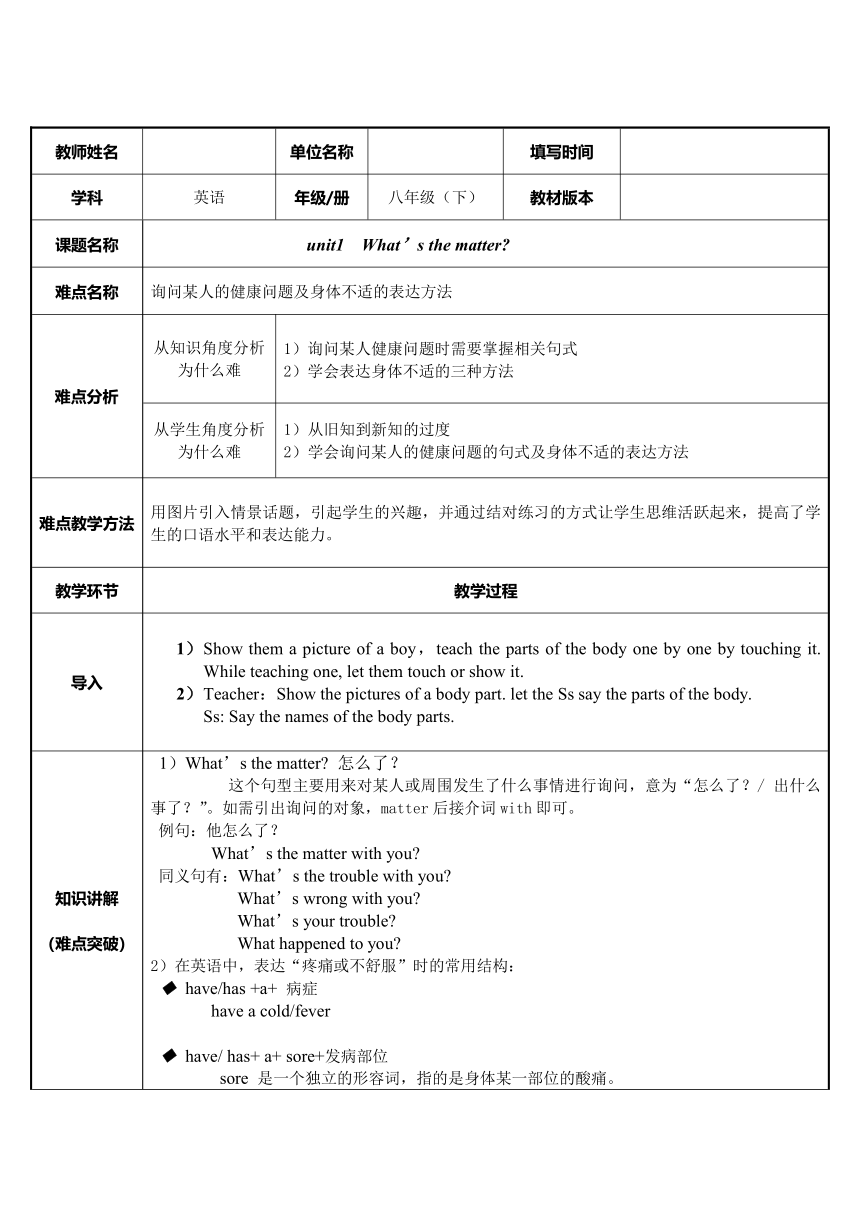Unit1 What’s the matter?询问某人的健康问题及身体不适的表达方法(表格式教案)
文档属性
| 名称 | Unit1 What’s the matter?询问某人的健康问题及身体不适的表达方法(表格式教案) |

|
|
| 格式 | docx | ||
| 文件大小 | 786.2KB | ||
| 资源类型 | 教案 | ||
| 版本资源 | 人教新目标(Go for it)版 | ||
| 科目 | 英语 | ||
| 更新时间 | 2022-03-26 11:39:21 | ||
图片预览

文档简介
教师姓名 单位名称 填写时间
学科 英语 年级/册 八年级(下) 教材版本
课题名称 unit1 What’s the matter
难点名称 询问某人的健康问题及身体不适的表达方法
难点分析 从知识角度分析为什么难 1)询问某人健康问题时需要掌握相关句式 2)学会表达身体不适的三种方法
从学生角度分析为什么难 1)从旧知到新知的过度 2)学会询问某人的健康问题的句式及身体不适的表达方法
难点教学方法 用图片引入情景话题,引起学生的兴趣,并通过结对练习的方式让学生思维活跃起来,提高了学生的口语水平和表达能力。
教学环节 教学过程
导入 Show them a picture of a boy,teach the parts of the body one by one by touching it. While teaching one, let them touch or show it. Teacher:Show the pictures of a body part. let the Ss say the parts of the body. Ss: Say the names of the body parts.
知识讲解 (难点突破) 1)What’s the matter 怎么了? 这个句型主要用来对某人或周围发生了什么事情进行询问,意为“怎么了?/ 出什么事了?”。如需引出询问的对象,matter后接介词with即可。 例句:他怎么了? What’s the matter with you 同义句有:What’s the trouble with you What’s wrong with you What’s your trouble What happened to you 2)在英语中,表达“疼痛或不舒服”时的常用结构: ◆ have/has +a+ 病症 have a cold/fever ◆ have/ has+ a+ sore+发病部位 sore 是一个独立的形容词,指的是身体某一部位的酸痛。 如:sore back, sore throat, sore neck. ◆ have/ has + a+部位-ache -ache作后缀,常与表示身体部位的名词合成一个新词,表身体某部位疼痛, 如:tooth(牙齿)+ache=toothache(牙痛) head(头)+ache=headache(头痛) back(背)+ache=backache(背痛) 表示身体不适的常用词组还有: have a bad cold 重感冒 have a fever 发烧 have a headache 头痛 have a stomachache 肚子痛;胃痛 have a toothache 牙痛
课堂练习 (难点巩固) A:You don’t look well. ____ with you B:I have a fever and can’t stop coughing. A. What’s happening B. What is it C. What’s on D. What’s the matter 2. Look at the pictures and guess what happened. She doesn’t look well. She has a __________ and a cough. He _______ look well. He _______________.
小结 1. 胃/肚子疼 have a stomachache 2. 脖子疼have a neckache/sore neck 3. 头疼have a headache 4. 嗓子疼, 喉咙疼have a sore throat 5. 背疼 have a sore back 6. 感冒 have/catch a cold 7. 发高/低烧 have a high/low fever 8. 咳嗽have a cough 9. 牙痛have a toothache
学科 英语 年级/册 八年级(下) 教材版本
课题名称 unit1 What’s the matter
难点名称 询问某人的健康问题及身体不适的表达方法
难点分析 从知识角度分析为什么难 1)询问某人健康问题时需要掌握相关句式 2)学会表达身体不适的三种方法
从学生角度分析为什么难 1)从旧知到新知的过度 2)学会询问某人的健康问题的句式及身体不适的表达方法
难点教学方法 用图片引入情景话题,引起学生的兴趣,并通过结对练习的方式让学生思维活跃起来,提高了学生的口语水平和表达能力。
教学环节 教学过程
导入 Show them a picture of a boy,teach the parts of the body one by one by touching it. While teaching one, let them touch or show it. Teacher:Show the pictures of a body part. let the Ss say the parts of the body. Ss: Say the names of the body parts.
知识讲解 (难点突破) 1)What’s the matter 怎么了? 这个句型主要用来对某人或周围发生了什么事情进行询问,意为“怎么了?/ 出什么事了?”。如需引出询问的对象,matter后接介词with即可。 例句:他怎么了? What’s the matter with you 同义句有:What’s the trouble with you What’s wrong with you What’s your trouble What happened to you 2)在英语中,表达“疼痛或不舒服”时的常用结构: ◆ have/has +a+ 病症 have a cold/fever ◆ have/ has+ a+ sore+发病部位 sore 是一个独立的形容词,指的是身体某一部位的酸痛。 如:sore back, sore throat, sore neck. ◆ have/ has + a+部位-ache -ache作后缀,常与表示身体部位的名词合成一个新词,表身体某部位疼痛, 如:tooth(牙齿)+ache=toothache(牙痛) head(头)+ache=headache(头痛) back(背)+ache=backache(背痛) 表示身体不适的常用词组还有: have a bad cold 重感冒 have a fever 发烧 have a headache 头痛 have a stomachache 肚子痛;胃痛 have a toothache 牙痛
课堂练习 (难点巩固) A:You don’t look well. ____ with you B:I have a fever and can’t stop coughing. A. What’s happening B. What is it C. What’s on D. What’s the matter 2. Look at the pictures and guess what happened. She doesn’t look well. She has a __________ and a cough. He _______ look well. He _______________.
小结 1. 胃/肚子疼 have a stomachache 2. 脖子疼have a neckache/sore neck 3. 头疼have a headache 4. 嗓子疼, 喉咙疼have a sore throat 5. 背疼 have a sore back 6. 感冒 have/catch a cold 7. 发高/低烧 have a high/low fever 8. 咳嗽have a cough 9. 牙痛have a toothache
同课章节目录
- Unit 1 What's the matter?
- Section A
- Section B
- Unit 2 I'll help to clean up the city parks.
- Section A
- Section B
- Unit 3 Could you please clean your room?
- Section A
- Section B
- Unit 4 Why don't you talk to your parents?
- Section A
- Section B
- Unit 5 What were you doing when the rainstorm came
- Section A
- Section B
- Review of Units 1-5
- Unit 6 An old man tried to move the mountains.
- Section A
- Section B
- Unit 7 What's the highest mountain in the world?
- Section A
- Section B
- Unit 8 Have you read Treasure Island yet?
- Section A
- Section B
- Unit 9 Have you ever been to a museum?
- Section A
- Section B
- Unit 10 I've had this bike for three years.
- Section A
- Section B
